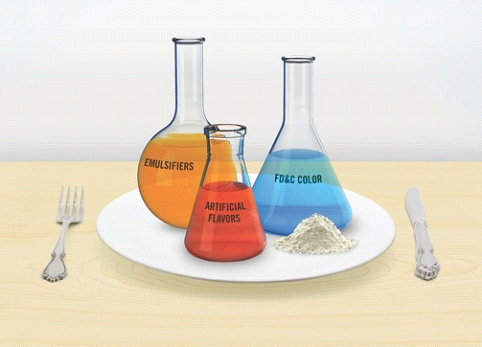Lookout for those chemicals and start lightening the load on your health.
They are mostly found in processed foods (even organic). Some make their way into toiletery and even medications. Aluminium for instance is used as an anti-perspirant and an anti-caking agent in antacids.
Their negative impact is made worse if they are in combination and children are especially sensitive.

| Sodium nitrite is added to meats like hot dogs and deli meat to help them maintain color. However, in the presence of heat, nitrites can combine with amines in processed meat to form nitrosamines, which are carcinogenic. A 2007 analysis found that eating just one sausage a day can significantly raise your risk of bowel cancer. |
Artificial colors. Nine of the food dyes currently approved for use in the US are linked to health issues ranging from cancer and hyperactivity to allergy-like reactions. Sodium benzoate (E211) is most widely used in acidic foods such as salad dressings, soda, fruit juices, pickles, and other condiments. It causes behavioural issues and children are particulrly suceptible |
| Potassium bromate is an endocrine-disrupting chemical commonly used in flour (bromated flour). Studies have linked it to kidney and nervous system damage, thyroid problems, cancer, and gastrointestinal discomfort. The International Agency for Research on Cancer classifies potassium bromate as a possible carcinogen. Potassium bromate is banned for food use in Canada, China, and the European Union (EU). | Butylated Hydroxytoluene (BHT) is chemically similar to BHA and the two preservatives are often used together. While BHT is not considered a carcinogen like BHA, it has been linked to tumor development in animals. It’s also been linked to developmental effects and thyroid changes in animal studies, which suggests it may be an endocrine-disrupting chemical. |
| Butylated hydroxyanisole (BHA) is a preservative that affects the neurological system of your brain and can alter behavior. According to the US Department of Health and Human Services, BHA "is reasonably anticipated to be a human carcinogen,” and it’s listed as a known carcinogen under California’s Proposition 65. BHA may also trigger allergic reactions and hyperactivity. BHA is banned from use in foods in certain parts of the EU and Japan. | Phosphates are added to more than 20,000 products, including fast food, baked goods, and processed meats. Phosphates have been linked to health conditions like heart disease. The European Food Safety Authority is currently reevaluating adding phosphates to food, but the results of their study aren’t expected until the end of 2018. |
|
Propyl gallate is associated with tumors, including rare brain tumors, in rats. Propyl-paraben is an endocrine-disrupting chemical used as a food preservative. Found in muffins, bread, tortilla chips and more than 50 brand names |
Diacetyl is anartificial flavoring often used to create butter, maple, strawberry, and raspberry flavors. Research shows diacetyl may have adverse effects on brain health and may trigger Alzheimer’s disease |
| “Natural and Artificial Flavors” could mean that one unnatural additive is included, or it could be a blend of hundreds of additives. Some natural flavors even contain propylene glycol, a solvent, or the preservative BHA. Genetically engineered flavor enhancers can also be listed under either the artificial or natural flavor label. One exception is certified organic natural flavors, which must meet more stringent guidelines and cannot contain synthetic or genetically engineered ingredients. | Aluminum additives. Sodium aluminum phosphate, sodium aluminum sulfate, and many other aluminumadditives are found in processed foods as stabilizers. This metal can accumulate and persist in your body, especially in your bones, and animal studies show aluminum may cause neurological effects, including changes in behavior, learning, and motor response. A link between Alzheimer’s disease and other neurodegenerative disorders and aluminum exposure may also exist. |

